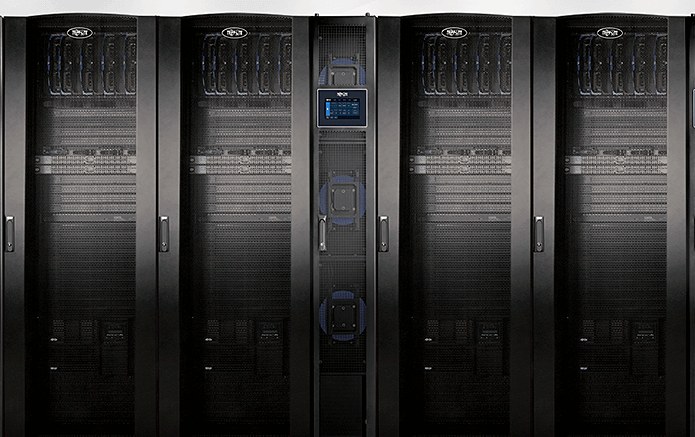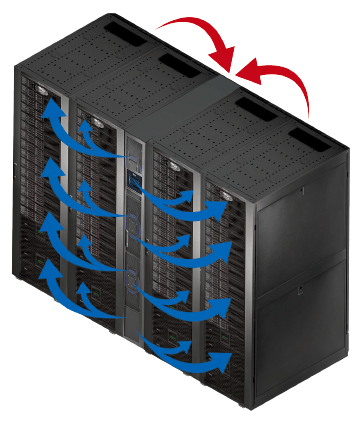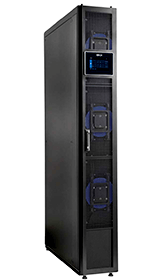
You’ve calculated how many servers and racks you’ll need in your small data center, and now it’s time to evaluate cooling options. There is a good chance one of the solutions on the table is an in-row unit.
High-density IT loads generate heat that often exceeds what building AC (“comfort cooling”) was designed to manage, or at least manage efficiently. Adding perimeter computer room air conditioning (CRAC) units has been a common solution to adequately cool data centers, but in-row AC units may make more sense for smaller installations.
How Does In-Row Cooling Work?
By placing precision, in-row cooling units next to the heat source, you can better focus cold air on your load and minimize hot air/cold air mixing. The potential total cost of ownership (TCO) gains from a dedicated in-row cooling solution are significant compared to a CRAC cooling system, and there is a high demand for them. Gartner predicts that by 2025, 70% of organizations will shift their focus “from big to small and wide data.” This shift will mean more small and mid-sized data centers, micro data centers and edge computing installations popping up—and more cooling solutions designed to support them. But how will you navigate this feature-rich market of options?
The Top 5 Factors to consider when choosing an in-row cooling solution for small and mid-size data centers are:
- Footprint
- Cooling Capacity
- Efficiency
- Adaptability
- Network Management
1. Footprint
Generally speaking, CRAC units require more data center white space than in-row cooling units, especially when you take into account the maintenance clearance space and airflow throw buffer that CRAC units require. But even among in-row units, there can be size discrepancies. Look for in-row units with ½ rack width (300 mm) to preserve the most room for racks and other equipment.
Also, be sure to check whether a unit requires a raised floor for installation. This would of course require up-front site modifications if a raised floor is not already in place, which might further restrict rack placement and free space. Some in-row AC units do not require a raised floor.
2. Cooling Capacity
A rack with a 5 kW load requires at least a 17,000 BTU cooling solution (with additional capacity consideration for peak output times), which is at the high end of the capacity for many portable AC units.
Fortunately, small in-row units with capacities up to 85,000 BTU/hr are available, helping you reliably meet the cooling needs of multiple rack loads.
3. Efficiency
As discussed, by using an in-row, precision solution, you will already be cooling more efficiently than you would by relying on building AC or a perimeter CRAC system for primary cooling, but there are additional efficiency features within in-row models to look for:
- Variable speed controls will help your cooling solution waste less energy during lower usage times.
- Electronically commutated (EC) fans can automatically adjust airflow based on heat load.
- Insulated paneling can better isolate units from external temperature variations.

In-row unit in flush installation directs air directly to the front of equipment.
4. Adaptability
Demands on your servers may fluctuate wildly, and the quantity of devices in your installation may go up and down as well. This means dramatic swings in power usage and dramatic swings in cooling requirements.
Look for units with simple scalability. Another benefit of AC units with a small footprint is they will leave you with more options for adding more units. An in-row unit with features that support simple installation and relocation, such as built-in casters, will pay dividends. Avoid models that require their own ductwork.
For redundancy, ensure that all in-row coolers support group communication so extra units can automatically “wake” from standby mode during high-capacity times or if a primary cooling unit falters.
Side airflow discharge capability makes a unit easier to install at the end of a row when desired.
5. Network Management
Look for units with network management capabilities so you can monitor and control them as devices on your LAN. This should include proactive, automated alerts when heat problems arise, which will help you respond quickly and potentially avert costly downtime and equipment damage.
Be sure that remote management is supported, especially for remote installations where on-site support is inconvenient if not occasionally impossible. Solutions with built-in network cards will make your setup simpler.

Conclusion
There are a number of cooling options that could be considered for a small-to-mid-size or edge-of-network IT installation—some in tandem with others. For high-density spaces with mission-critical servers, a dedicated in-row solution should be evaluated.
The SmartRack In-Row Precision Series cooling units from Tripp Lite meet all the criteria recommended in this piece. A 12 kW and a 25 kW model capture heat at the source to improve energy efficiency by 25% over traditional perimeter CRACs. Each unit provides robust cooling for up to five racks and can be easily scaled—ensuring long-term reliability and an improved TCO.
Recommended Models:
See our full range of solutions for meeting all your cooling needs:





